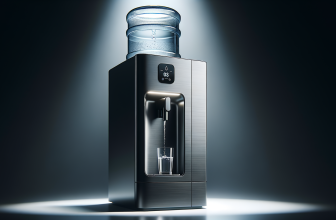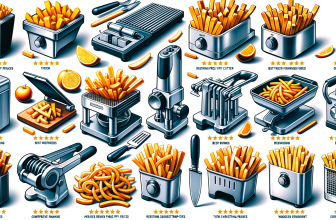
Ever found yourself with a beautiful cut of meat that turned out too tough after cooking? A meat tenderizer could be the secret weapon in your kitchen arsenal. But with so many options available, how can you choose the right one that will turn your meat into a melt-in-your-mouth masterpiece?
Our Top Picks
Our #1 Top Pick: Jaccard 48-Blade Meat Tenderizer
This well-designed product features 48 stainless steel blades that penetrate the meat easily, breaking down the fibers that can make it chewy. The Jaccard Meat Tenderizer is easy to clean, with the blades that easily disassemble for thorough washing, and it’s safe to use in the dishwasher. It’s sturdy and durable, making it a favorite among home cooks and professional chefs alike. Plus, the device’s rectangular shape allows for even coverage on large cuts, ensuring no bite is left untender.
Pick #2: OXO Good Grips Meat Tenderizer
OXO’s Good Grips Meat Tenderizer is a dual-sided mallet-style tenderizer with a comfortable handle that absorbs pressure as you work. One side is flat for pounding, while the other is textured for tenderizing, giving it versatility. The aluminum construction is solid, and it has a non-slip grip that is helpful when your hands are wet or slippery. Simple yet effective, this tenderizer works well for those who prefer a more traditional approach to meat tenderization.
Pick #3: Norpro Professional Meat Tenderizer
Norpro’s Professional Meat Tenderizer stands out with its unique design, featuring stainless steel prongs that retract as you press down and release when lifted. This motion ensures that the meat isn’t shredded but is evenly tenderized, keeping the cut intact. The ergonomic handle provides a good grip, adding comfort and control. It’s an effective tool, particularly for more delicate tenderizing tasks.
Pick #4: KLEMOO Meat Tenderizer Tool
The KLEMOO Meat Tenderizer Tool is an affordable option that doesn’t skimp on quality. Featuring 48 ultra sharp stainless steel blades, this tenderizer creates tiny channels within the meat, helping it to cook more evenly and also reducing cooking time. It works great on various meats including beef, chicken, pork, and veal. The device is also equipped with a safety lock, ensuring the blades are stored safely when not in use.
Pick #5: Chef-Master Meat Tenderizer Tool
For those who prefer commercial-grade tools, the Chef-Master Meat Tenderizer Tool offers a robust solution. It has 48 razor-sharp blades and is constructed of durable materials, designed to withstand the rigors of busy kitchens. The tool’s design allows it to be easily taken apart for cleaning, which is a bonus for any busy cook. It’s suitable for use on a variety of meats, making it a versatile pick for any kitchen.
What to Know Before You Buy
- Type of Tenderizer: Understand the types of meat tenderizers available. Mallets are great for flattening meat, while blade tenderizers are better for tougher cuts.
- Material: Quality materials like stainless steel are durable and last longer. Ensure that handles are sturdy and comfortable for long-term use.
- Size: The size of the tenderizer should match your most common uses. Larger tenderizers suit bigger cuts of meat, while smaller ones are good for serving-size portions.
- Ease of Cleaning: A tenderizer should be easy to clean, ideally dishwasher-safe, to ensure no meat residue sticks to it. This is crucial for food safety.
Factors to Consider Before Buying
- Quality of Blades: Look for blades that are sharp, durable, and won’t rust over time. This is particularly important in blade-style tenderizers.
- Ergonomics: If using a mallet or a manual blade tenderizer, the handle should feel comfortable and provide a good grip to prevent fatigue or injury.
- Safety Features: Some tenderizers come with a locking mechanism for the blades or a protective cover for mallets, which are valuable safety features.
- Compatibility with Meat Cuts: Consider the types of meat you typically cook. Not all tenderizers work well on all meat types, so find one that is most compatible with your cooking habits.
Why Trust ChooseRight?
You might be wondering why you should trust these recommendations. At ChooseRight, we don’t just rely on manufacturer’s claims; we thoroughly review products, assessing the hands-on experience, performance, and durability. We dive into thousands of authentic user reviews to gauge common customer experiences. And perhaps most importantly, we solicit feedback from professionals in the culinary field, ensuring that our suggestions stand up to real-world kitchen demands. When we say we’ve found the best meat tenderizer, we mean it.
Finishing Thoughts
Selecting the right meat tenderizer can transform your cooking, elevating even the toughest cuts to culinary delights. Whether you’re a casual cook or a professional, finding the ideal tenderizer means looking at material quality, size, ergonomics, and compatibility with your cooking style. Armed with our top picks, you’re well on your way to achieving tender and juicy meat every time. Happy cooking!
Frequently Asked Questions
What is a meat tenderizer?
A meat tenderizer is a tool or ingredient used to soften meat fibers, making the meat easier to chew and digest. It can come in physical forms such as mallets or blades, or as a powder made from natural enzymes.
How does a meat tenderizer tool work?
A meat tenderizer tool, such as a mallet, pounds the meat, breaking down the muscle fibers and connective tissues. This makes the meat less tough. Modern tenderizers with blades or needles pierce the meat, achieving the same effect with less effort.
Can I tenderize meat without a tenderizer?
Yes, there are natural alternatives to tenderize meat, such as using acidic ingredients like lemon juice, vinegar, or yogurt; fruit enzymes found in papaya (papain) or pineapple (bromelain); or simply marinating your meat for a longer period of time.
When should I use a meat tenderizer?
Use a meat tenderizer when cooking tougher cuts of meat like chuck, round, flank, or skirt steak to improve their texture and taste. It’s also useful when you want to decrease cooking time by making the meat thinner and more uniform in thickness.
Is using a meat tenderizer safe?
Yes, using a meat tenderizer is safe as long as you follow the product’s instructions and handle the tool carefully, especially if it has sharp blades or needles. When using powdered tenderizers, ensure they are well cooked to avoid any potential digestive issues.
Will a meat tenderizer affect the flavor of my meat?
Physical tenderizers such as mallets or blades do not affect the flavor. Powdered tenderizers may impart a subtle flavor, depending on the active ingredients used. Always follow the recommended quantities to avoid overpowering the natural taste of the meat.
How long should I leave the meat tenderizer on before cooking?
When using a powdered tenderizer, it’s usually recommended to apply it to the meat and let it sit for 15 minutes to 1 hour, depending on the size and cut of the meat. Check the product instructions for the specific recommended time.
Can meat tenderizer make meat too soft?
Yes, over-tenderizing can make meat mushy. To prevent this, tenderize the meat to the desired texture, depending on the cooking method and personal preference, and avoid excessive pounding or prolonged use of enzymatic tenderizers.
Is there a difference between a manual and electric meat tenderizer?
A manual meat tenderizer is typically operated by hand, using a mallet or roller with spikes. An electric meat tenderizer automates the process and is more efficient for tenderizing large quantities of meat or for commercial use.
Can I use a meat tenderizer on all types of meat?
While meat tenderizers are most commonly used on tougher cuts of red meat, they can also be used on poultry and even certain types of fish. However, the need for tenderizing and the method used may vary between types of meat.







